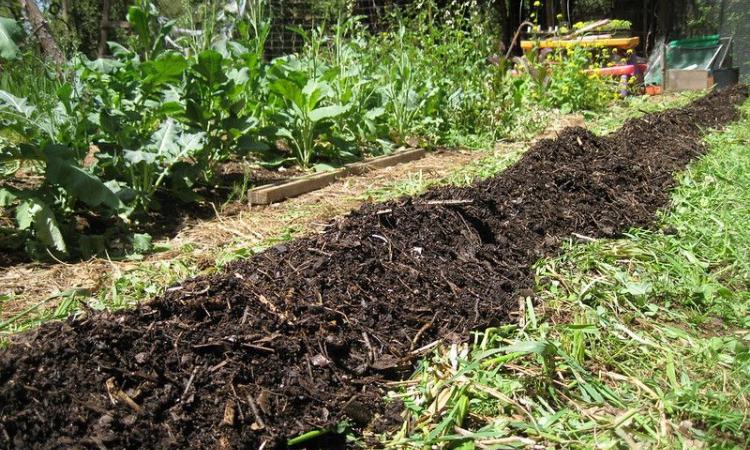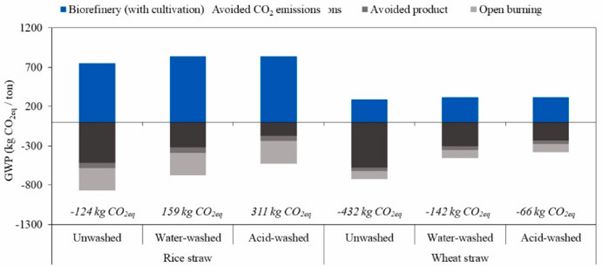
Crop residues are an abundantly available lignocellulosic feedstock that can provide multiple value-added products in a biorefinery (Kamm, 2007). However, approximately 24% of the generated residue is burned in the fields in India (Ravindra et al., 2019).
The open burning results in nearly 211 Tg (Teragram, 1012g) of CO2eq greenhouse gases annually and 824 Gg (Gigagram, 109 g) of particulate matter (Ravindra et al., 2019). Further, open burning increases fertilizer and pesticide requirements to maintain productivity due to heat damage to soil microbial health (Cassou, 2018).
Governments' regulatory efforts have not significantly reduced residue burning (Kaushal, 2020; Shyamsundar et al., 2019). Rice straw and wheat straw burning are prevalent in India due to limited time for land clearing between cropping cycles, prohibitive costs of land-clearing equipment, and low to no profit margins in the sale of residues (Cassou, 2018). Hence, this practice needs to be addressed by incentivizing farmers with economical and environmentally viable solutions through joint actions from the government and private sectors.
Globally, integrated biorefineries which combine decentralized pyrolysis and centralized refining of bio-oil have been proposed to address issues of open burning (Cherubini and Ulgiati, 2010). Such biorefineries can be operated on farms, saving time/energy for residue transportation, meeting the local energy demand, and increasing farmer incomes through value-addition to the residues.
Recent developments in pyrolysis-based residue treatment have been listed in the supporting information. These studies show that a pyrolysis unit can be a self-sustaining that is the required process heat can be supplied by burning part of the generated biochar or pyrolysis gases (Morgano et al., 2018).
Pyrolysis also brings environmental savings because biochar can be used for carbon sequestration or a fossil coal substitute (Peters et al., 2015). Further, there are environmental savings from the avoided burning of residues (Chhabra et al., 2021) and profits from the production of higher-value products. For instance, bio-oil-derived levoglucosan showed a 75% lower global warming potential than its petrochemical alternative (Zheng et al., 2018).
Despite the benefits, there are conflicting views on the economic feasibility of decentralized biorefineries compared to fixed centralized refineries. Xin et al. (2021) showed that although the capital investment on a fixed 100-ton facility (US$ 1.2 million) was higher than a mobile 25-ton unit (US$ 0.5 million), the profits from a fixed unit exceeded the mobile unit due to a larger scale of production.
In contrast, Chen et al. (2018) showed that the fixed plant (4000 kg/h) had a lower initial investment, but the mobile plant (100 kg/h) had a lower biofuel production cost and larger profit margins. The mobile system was profitable in the 6th year, while the fixed system took 7 years. Hence, performing regional and biomass-specific environmental and economic assessments is essential.
The current study published in the Journal of Cleaner Production (Volume 367) ‘Techno-economic and environmental assessment of decentralized pyrolysis for crop residue management: Rice and wheat cultivation system in India’ evaluates a decentralized biorefinery's economic and environmental performance, which uses two-step pyrolysis for converting rice and wheat straw to bio-oil and biochar. The biorefinery was located in Punjab, a major rice and wheat-producing state where open burning of residue is prevalent.
The rice grain produced is 12.8 million tons/year with a yield of 4132 kg/ha, and wheat grain is 18.2 million tons/year with a yield of 5188 kg/ha (Directorate of Economics and Statistics, 2019). Due to the limited accessibility, it was assumed that only 50% of the residual straw generated was available for pyrolysis (Singh, 2017).
The pyrolysis unit was estimated to operate 328 days a year and have a capacity for pyrolysis of 10 tons of dry straw per day. The annual straw requirement for one pyrolysis unit was calculated to be 3.28 kilotons (kt).
The decentralized biorefinery was evaluated regarding the energy required for pyrolysis, product yield and applications, and global warming potential. Pyrolysis of unwashed, water-washed, and acid-washed straws was performed.
The net global warming potential for pyrolysis of unwashed rice straw was −121 kg CO2eq/ton when biochar was used as a carbon sink. But pyrolysis of water-washed (159 kg CO2eq/ton) and acid-washed rice straw (311 kg CO2eq/ton) was a net contributor to global warming potential, which was undesirable. Similar trends were observed for wheat straw pyrolysis.
The global warming potential of washed rice and wheat straw pyrolysis was higher than unwashed straw because 37–50% biochar generated was used for drying the washed straw, leaving less biochar for further application. Amongst the biochar applications considered, its use as a carbon sink offered more global warming potential reduction than its use as a substitute for coal in power and heat generation.
The net global warming potential for direct transfer of residues to a centralized refinery for pyrolysis was −75 kg CO2eq/ton for rice straw and −384 kg CO2eq/ton for wheat straw. Therefore, it was environmentally beneficial to treat biomass locally rather than in a centralized unit.
Impact of biochar use in soil
The environmental performance of biorefinery when biochar was used in the soil is shown in the figure below. The global warming potential credits, shown as negative values, included avoided emissions from open burning, avoided chemical fertilizer (N–P–K), and avoided CO2eq from putting char in soil. Due to uncertainty in measurement, it is assumed that biochar from all pyrolysis cases substituted the same amount of fertilizers.

Conclusion
The current study showed that decentralized pyrolysis of unwashed straw is an environmentally more suitable alternative for crop residue management. However, washed straw produces more high-value chemicals in the bio-oil than unwashed straw.
The decentralized biorefinery proposed in this study offers environmental savings from avoided emissions through open burning of RS (−285 kg CO2eq/ton straw) and WS (−106 kg CO2eq/ton straw) on the field and from using biochar as a carbon sink in soil.
The pyrolysis unit could be self-sustaining using pyrolysis gases and biochar. The net GWP from decentralized pyrolysis of RS was −124 kg CO2eq/ton straw compared to −75 kg CO2eq/ton straw for centralized biorefinery, indicating that it was better to treat biomass locally.
Finally, with an all-year-round operation, the minimum selling price for biochar was calculated to be 172–623 USD/ton, which was within the range of commercial biochar price. Therefore, the proposed biorefinery was expected to be environmentally and economically viable with an appropriate selection of pretreatment options and end-uses of the products.
The full paper can be accessed here